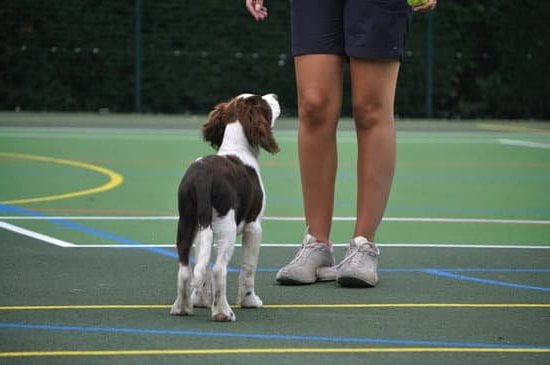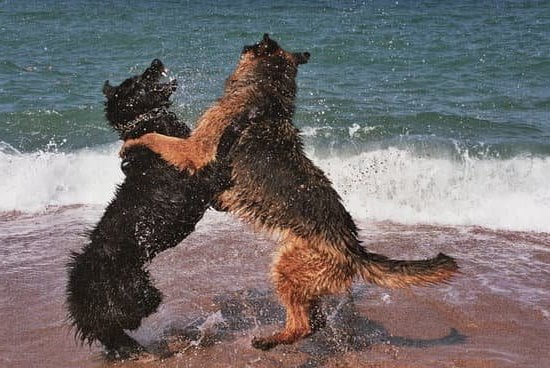Are you wondering what length leash for dog training is most effective? Training your furry companion requires careful consideration of various factors, including the proper leash length. Understanding the importance of a suitable leash length is crucial for successful dog training sessions. In this article, we will explore the significance of choosing the right leash length for dog training and provide valuable insights into how it can impact your training efforts.
When it comes to dog training, the leash is an essential tool that aids in controlling your pet’s movements and behavior. The length of the leash plays a pivotal role in shaping your dog’s response to commands and ensuring their safety during training exercises. Whether you are teaching obedience, agility, or any other skill, the right leash length can make a significant difference in achieving your training goals.
As we delve deeper into this topic, we will discuss various aspects related to choosing the appropriate leash length for dog training. From understanding the different types of leashes available to exploring the benefits of using a shorter leash for training purposes, we will provide comprehensive guidance on making informed decisions when it comes to selecting the ideal leash length for your canine companion.
Additionally, we will examine common mistakes to avoid and offer valuable tips for proper leash handling during training sessions.
Stay tuned as we uncover everything you need to know about finding the perfect leash length for successful dog training. Whether you are a seasoned pet owner or a novice trainer, our detailed insights will help you navigate through this important aspect of canine education with confidence and expertise.
Types of Leashes for Dog Training
When it comes to dog training, the type of leash you choose can make a big difference in how well your training sessions go. Two common types of leashes used for dog training are fixed length leashes and retractable leashes. Each type has its own set of advantages and disadvantages, and understanding these differences can help you choose the right leash for your specific training needs.
Fixed length leashes are a traditional option that provides stability and control during training sessions. These leashes come in various materials, including nylon, leather, or cotton, and typically have a clip on one end that attaches to your dog’s collar or harness. The length of fixed leashes can vary, but they do not extend or retract like their counterpart.
On the other hand, retractable leashes consist of a long cord wound around a spring-loaded device housed inside a plastic handle. They allow dogs more freedom to roam further away from their owners due to the extended range provided by the leash’s locking mechanism. However, some trainers feel that this added freedom may hinder positive behavior reinforcement due to less control by the handler.
| Fixed Length Leash | Retractable Leash |
|---|---|
| Provides stability and control | Allows dogs more freedom to roam |
| Does not extend or retract | Consists of a long cord wound around a spring-loaded device |
| Available in various materials such as nylon, leather, or cotton | Housed inside a plastic handle with locking mechanism |
Factors to Consider When Choosing the Right Length Leash for Dog Training
When choosing the right length leash for dog training, there are several factors to consider to ensure successful and effective training sessions. One of the most important factors is the size and breed of the dog. Larger breeds may require a longer leash for freedom of movement during training, while smaller breeds may need a shorter leash for better control and handling.
Another factor to consider is the specific training goals and techniques being used. For obedience training and teaching commands, a shorter leash is often recommended as it allows for better communication and control between the trainer and the dog. On the other hand, for activities such as agility training or recall exercises, a longer leash may be more suitable to give the dog more space to move around.
The environment where the training will take place also plays a crucial role in determining the appropriate leash length. In crowded or urban settings, a shorter leash can help keep the dog close and prevent distractions or unwanted interactions with other people or animals. Conversely, in open or outdoor spaces, a longer leash can provide more freedom for exploration while still maintaining control over the dog’s behavior.
| Factors to Consider | Recommendation |
|---|---|
| Size and breed of the dog | Consider whether your dog needs more freedom of movement or better control |
| Training goals and techniques | Determine if you need better communication and control or more space for movement |
Benefits of Using a Shorter Leash for Training Purposes
When it comes to dog training, the length of the leash you use can have a significant impact on the overall success of your training sessions. Using a shorter leash for training purposes offers several benefits that can help you effectively communicate with and control your dog.
Improved Communication and Control
One of the key benefits of using a shorter leash for training is improved communication and control. With a shorter leash, you are able to maintain better physical proximity to your dog, allowing you to more effectively guide their movements and correct any unwanted behaviors. This close proximity also allows for clearer verbal and physical cues, making it easier for your dog to understand what is expected of them during training exercises.
Prevention of Unwanted Behaviors
Using a shorter leash can also help prevent unwanted behaviors such as pulling, lunging, or jumping. The limited length of the leash restricts your dog’s freedom of movement, making it more difficult for them to engage in these undesirable actions. This can be especially helpful when working on obedience training or addressing behavioral issues such as aggression or over-excitement.
Enhanced Safety During Training
Shorter leashes also provide an added layer of safety during training sessions, both for your dog and those around you. With a shorter leash, you have greater control over your dog’s movements in potentially dangerous situations, such as encountering other dogs or navigating busy streets. This reduced freedom can help prevent accidents and ensure that your dog remains safe and secure during training exercises.
Drawbacks of Using a Longer Leash for Dog Training
Reduced Control and Communication
Using a longer leash during dog training can lead to reduced control and communication between the owner and the dog. With a longer leash, it becomes more difficult to give immediate feedback or corrections to the dog, which can result in confusion or a lack of understanding of what is expected during training sessions. This can hinder the progress of the training and make it harder for the dog to learn new commands or behaviors.
Potential Safety Risks
Another drawback of using a longer leash for dog training is the potential safety risks that come with it. A longer leash increases the risk of entanglement for both the dog and the owner, especially in crowded or busy areas.
The chances of tripping over the leash are also higher with a longer length, which can result in injuries for both the owner and the dog. Additionally, if a dog is not properly trained or under control, a longer leash can allow them to wander into unsafe areas or approach unfamiliar dogs without proper supervision.
Ineffective Training Sessions
Longer leashes can also lead to ineffective training sessions, as they provide more opportunities for distractions and unwanted behaviors. With greater freedom to roam around, dogs may become easily distracted by environmental stimuli or other animals, making it harder for them to focus on their training.
This can result in slower progress in learning new commands or behaviors, as well as reinforcement of undesirable habits due to lack of timely correction from the owner. Ultimately, using a longer leash for training purposes may prolong the time it takes for a dog to reach its training goals and could lead to frustration for both the owner and the pet.
Tips for Proper Leash Handling During Training Sessions
Proper leash handling during training sessions is crucial for the success of your dog’s training. One important tip for proper leash handling is to hold the leash with a relaxed grip. A tight grip on the leash can make your dog feel restricted and may lead to tension in the training session. It’s important to maintain a firm but gentle hold, allowing your dog to have some freedom of movement while still being under your control.
Another tip is to keep the leash short enough to maintain control over your dog, especially during early stages of training. A shorter leash allows you to give quick corrections and guidance to your dog without giving them too much slack or freedom. However, it’s essential to avoid pulling or yanking on the leash, as this can cause discomfort and confusion for your dog.
Additionally, it’s crucial to always be aware of your surroundings when handling the leash during training sessions. Be mindful of potential distractions or hazards that could cause your dog to pull or lunge unexpectedly. By staying alert and proactive, you can anticipate and prevent any potentially problematic situations that may arise during training. Following these tips for proper leash handling will contribute greatly to successful and effective dog training sessions.
Common Mistakes to Avoid When Using a Leash for Dog Training
When it comes to dog training, using a leash is essential for controlling and guiding your pet. However, there are common mistakes that many dog owners make when using a leash for training purposes. Here are some of the most important mistakes to avoid:
- Using an inappropriate leash length: One of the most common mistakes in dog training is using the wrong length leash. A leash that is too long can result in your dog wandering off or getting tangled, while a leash that is too short can restrict your dog’s movement and cause frustration.
- Incorrect handling of the leash: Improper handling of the leash can lead to confusion for your dog and make training less effective. It’s important to hold the leash with a firm but not overly tight grip, and to avoid wrapping the leash around your hand or fingers.
- Allowing the leash to become tangled: Allowing the leash to become tangled around your dog’s legs or objects in the environment can be frustrating and confusing for your pet. It’s important to keep an eye on the leash at all times and prevent tangling from occurring.
Avoiding these common mistakes can make your dog training sessions more effective and enjoyable for both you and your pet. By choosing the right length leash, handling it properly, and preventing tangling, you’ll set yourself up for successful training sessions with your furry friend.
Recommended Leash Lengths for Different Training Scenarios
When it comes to dog training, choosing the right leash length is crucial for ensuring success. Different training scenarios call for different leash lengths to effectively train your dog and keep them safe. The recommended leash length can vary depending on the environment and specific training goals.
For obedience training in a crowded and public place, a shorter leash is recommended. A leash that is 4-6 feet in length provides better control over your dog, especially when navigating through busy areas with distractions. This length allows you to maintain close supervision of your dog and easily correct any unwanted behaviors.
On the other hand, when working on commands such as “stay” or “down” where you need your dog to have more freedom to move around, a longer leash may be more suitable. A 10-15 foot training lead can provide your dog with the necessary space to practice these commands while still being under control.
In off-leash training scenarios, such as recall training in an open field or park, a longer leash or a retractable leash may be preferred. A 20-30 foot long line or retractable leash gives your dog the freedom to explore while still allowing you to maintain control and guide their behavior when necessary. Ultimately, considering the specific training scenario will help determine the most appropriate leash length for successful training sessions with your canine companion.
How to Gradually Increase Leash Length as Training Progresses
As training progresses, it is important to gradually increase the leash length to give your dog more freedom while still maintaining control. This gradual increase in leash length will help your dog transition from close supervision and guidance to greater independence. It can also help build trust between you and your dog as they demonstrate good behavior and responsiveness to commands.
One way to gradually increase the leash length during training is by starting with a shorter leash, such as a 4-foot fixed-length or retractable leash, and gradually transitioning to a longer leash as your dog becomes more responsive to commands and exhibits improved behavior.
For example, once your dog consistently responds to basic commands such as sit, stay, and come while on a 4-foot leash, you can then progress to a 6 or 8-foot leash for additional freedom during training sessions.
It is important to observe your dog’s behavior closely when increasing the length of the leash. If you notice that your dog starts exhibiting undesirable behavior or becomes less responsive when given more freedom with a longer leash, it may be necessary to revert back to a shorter length until they are ready for the next step in their training.
This gradual process helps ensure that your dog remains under control while allowing them the opportunity to explore within safe limits as they continue developing good behavior and obedience skills.
Conclusion
In conclusion, the length of the leash used during dog training plays a crucial role in the overall success of the process. Understanding the importance of a proper leash length and considering factors such as training goals, dog breed, and behavior are essential when selecting the right leash for training purposes.
It is important to weigh the benefits of using a shorter leash, such as improved control and focus, against the drawbacks of using a longer leash, which may lead to distractions and lack of control.
Proper leash handling during training sessions is also key to successful dog training. Avoiding common mistakes such as wrapping the leash around your hand or allowing it to drag on the ground can help prevent accidents and maintain better control over your dog. As training progresses, gradually increasing the leash length can also be beneficial in allowing your dog more freedom while still maintaining control.
Ultimately, finding the perfect leash length for successful dog training requires careful consideration and an understanding of both your dog’s needs and your training goals. Whether it’s a fixed-length or retractable leash, choosing the right length for different training scenarios will ultimately contribute to a positive and effective training experience for both you and your canine companion.
With proper research and consideration, you can find a leash that suits your needs and enhances the effectiveness of your dog training efforts.
Frequently Asked Questions
Is a 4ft or 6ft Leash Better?
The choice between a 4ft and 6ft leash depends on the specific needs of the dog and its owner. A 4ft leash provides more control and is better suited for crowded or high-traffic areas, while a 6ft leash offers more freedom of movement during walks.
Ultimately, the best option will depend on the size, behavior, and training of the dog.
Are Short Leashes Good for Training?
Short leashes can be beneficial for training certain behaviors such as loose-leash walking and obedience commands. They provide better control over the dog’s movements and can help reinforce proper walking etiquette. However, it’s important to gradually introduce longer leashes as the dog progresses in its training to ensure that it learns how to behave in different contexts.
Is a 10 Foot Leash Too Long?
Whether a 10-foot leash is too long depends on the specific circumstances of each situation. While it may provide more freedom for the dog to explore during walks or outdoor activities, it also requires a responsible owner who can maintain control over the dog from a distance.
In open spaces or during off-leash training, a longer leash may be suitable, but in crowded areas or for dogs with limited training, it could be challenging to manage effectively.

Welcome to the blog! I am a professional dog trainer and have been working with dogs for many years. In this blog, I will be discussing various topics related to dog training, including tips, tricks, and advice. I hope you find this information helpful and informative. Thanks for reading!





